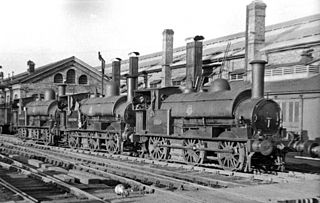
The steam locomotives of British Railways were used by British Railways over the period 1948–1968. The vast majority of these were inherited from its four constituent companies, the "Big Four".
British Railways coach designations were a series of letter-codes used to identify different types of coaches, both passenger carrying and non-passenger carrying stock (NPCS). The code was generally painted on the end of the coach but non-gangwayed stock had the code painted on the side. They have been superseded by TOPS design codes.

Wolverton railway works, known locally as Wolverton Works or just The Works, was established in Wolverton, Buckinghamshire, by the London and Birmingham Railway Company in 1838 at the midpoint of the 112-mile-long (180-kilometre) route from London to Birmingham. The line was developed by Robert Stephenson following the great success of the Liverpool and Manchester Railway line.

Crewe Works is a British railway engineering facility, built in 1840 by the Grand Junction Railway. It is located in the town of Crewe, in Cheshire. It is currently owned by Bombardier Transportation.

Ashford railway works was in the town of Ashford in the county of Kent in England.

Caerphilly railway works in Caerphilly in the county of Glamorgan was the only main railway works in Wales.
Wolverhampton railway works was in the city of Wolverhampton in the county of Staffordshire, England. It was almost due north of the city centre, and is commemorated with a small display of level crossing gates and a plaque. Known as the Stafford Road Works, it was opened by the Shrewsbury and Birmingham Railway in 1849 to maintain bought-in locomotives.

Swindon railway works was opened by the Great Western Railway in 1843 in Swindon, Wiltshire, England. It served as the principal west England maintenance centre until closed in 1986.
Stoke railway works was set up in 1864 by the North Staffordshire Railway in the city of Stoke-on-Trent in the county of Staffordshire, England.

Darlington railway works, was established in 1863 by the Stockton and Darlington Railway in the town of Darlington in the north east of England. The main part of the works, the North Road Shops was located on the northeast side of the Stockton and Darlington Railway

Doncaster Railway Works is a plant located in the town of Doncaster, South Yorkshire, England.

Horwich Works was a railway works built in 1886 by the Lancashire and Yorkshire Railway (LYR) in Horwich, near Bolton, in North West England when the company moved from its original works at Miles Platting, Manchester.

Eastleigh Works is a locomotive, carriage and wagon building and repair facility in the town of Eastleigh, in the county of Hampshire in England.

Brighton railway works was one of the earliest railway-owned locomotive repair works, founded in 1840 by the London and Brighton Railway in Brighton, England, and thus pre-dating the more famous railway works at Crewe, Doncaster and Swindon. The works grew steadily between 1841 and 1900 but efficient operation was always hampered by the restricted site, and there were several plans to close it and move the facility elsewhere. Nevertheless, between 1852 and 1957 more than 1200 steam locomotives as well as prototype diesel electric and electric locomotives were constructed there, before the eventual closure of the facility in 1962.

Cowlairs Locomotive, Carriage and Wagon Works, at Cowlairs in Springburn, an area in the north-east of Glasgow, Scotland, was built in 1841 for the Edinburgh and Glasgow Railway and was taken over by the North British Railway (NBR) in 1865. It was named after the nearby mansion of Cowlairs, with both locomotive and carriage & wagon works. It was also the first works in Britain to build locomotives, carriages and wagons in the same place. It was located on the western side of the Glasgow-Edinburgh mainline at Carlisle Street.

Glasgow Works, formerly the St Rollox Works, is a railway rolling stock heavy maintenance and repair works established in the 1850s in the Glasgow district of Springburn by the Caledonian Railway Company, and known locally as 'the Caley'.

The GER Class G58 was a class of 0-6-0 steam tender locomotives designed by James Holden for the Great Eastern Railway in England. The class consisted partly of new locomotives built from 1905 to 1911 and partly of rebuilds of the earlier GER Class F48 built from 1900 to 1903. The rebuilding started under GER auspices from 1921 and was continued by the London and North Eastern Railway (LNER) after grouping in 1923.

Nine Elms locomotive works were built in 1839 by the London and South Western Railway (LSWR) adjoining their passenger terminus near the Vauxhall end of Nine Elms Lane, in the district of Nine Elms in the London Borough of Battersea. They were rebuilt in 1841 and remained the principal locomotive carriage and wagon workshops of the railway until closure in stages between 1891 and 1909. Thereafter a large steam motive power depot remained open on the site until 1967, serving Waterloo railway station.

Gorton Locomotive Works, known locally as Gorton Tank, was in West Gorton in Manchester, England and was completed in 1848 by the Sheffield, Ashton-under-Lyne and Manchester Railway.
Bow railway works was at Bow, an area of London, England, in the London Borough of Tower Hamlets. It was built in 1853 by the North London Railway.